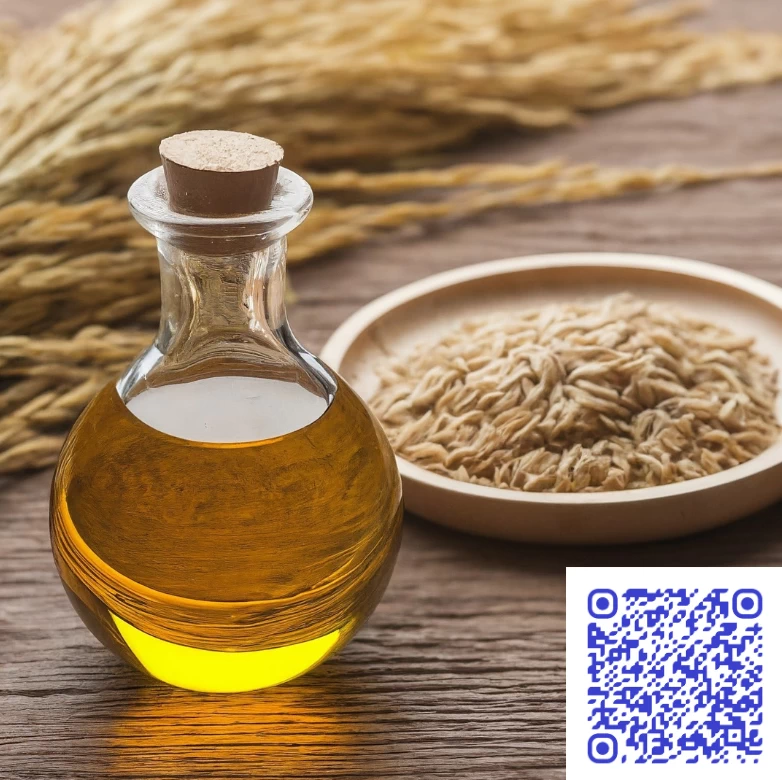
หน้าหลัก | สุขภาพดี | สุภาพสตรี | การแปลผลเลือด | โรคต่างๆ | วัคซีน | อาหารเพื่อสุขภาพ
น้ำมันรำข้าว: คุณสมบัติ สารอาหาร และประโยชน์ต่อสุขภาพ
บทนำ
น้ำมันรำข้าวคือน้ำมันที่สกัดจากรำข้าวและจมูกข้าว ซึ่งเป็นชั้นนอกของเมล็ดข้าวที่ได้จากการสีข้าว น้ำมันนี้ได้รับความนิยมในวงการสุขภาพและการปรุงอาหาร เนื่องจากอุดมไปด้วยวิตามินอี แกมมา-โอรีซานอล และสารต้านอนุมูลอิสระที่มีประโยชน์ต่อร่างกาย ช่วยลดความเสี่ยงของโรคหัวใจและหลอดเลือด ควบคุมระดับน้ำตาลในเลือด บำรุงผิวพรรณ และเสริมสร้างระบบภูมิคุ้มกัน นอกจากนี้ น้ำมันรำข้าวยังมีจุดเกิดควันสูง (ประมาณ 232-250°C หรือ 450°F) ทำให้เหมาะสำหรับการปรุงอาหารด้วยความร้อนสูง เช่น การทอดและผัด บทความนี้จะเจาะลึกถึงคุณสมบัติ สารอาหาร กระบวนการผลิต และประโยชน์ของน้ำมันรำข้าว
คุณสมบัติของน้ำมันรำข้าว
น้ำมันรำข้าวมีคุณสมบัติเด่นที่เหมาะสำหรับทั้งการปรุงอาหารและการดูแลสุขภาพ:
- จุดเกิดควันสูง: ทนความร้อนได้ถึง 232-250°C เหมาะสำหรับการทอด ผัด หรือย่าง โดยไม่สลายตัวและผลิตสารประกอบที่เป็นอันตราย
- รสชาติและกลิ่น: มีรสชาติอ่อน ๆ ไม่กลบรสชาติของอาหาร และมีกลิ่นหอมอ่อนคล้ายข้าว
- สี: มีสีเหลืองอ่อนถึงน้ำตาลอ่อน ขึ้นอยู่กับกระบวนการสกัด
ข้อมูลโภชนาการ
น้ำมันรำข้าว 1 ช้อนโต๊ะ (14 กรัม) ประกอบด้วย:
- แคลอรี่: 120
- โปรตีน: 0 กรัม
- ไขมัน: 14 กรัม
- คาร์โบไฮเดรต: 0 กรัม
- ไฟเบอร์: 0 กรัม
- น้ำตาล: 0 กรัม

ส่วนประกอบของน้ำมันรำข้าว
กรดไขมัน
น้ำมันรำข้าวมีสัดส่วนกรดไขมันที่สมดุล:
- ไขมันไม่อิ่มตัวเชิงเดี่ยว (Monounsaturated Fats): ~40% (เช่น กรดโอเลอิก)
- ไขมันไม่อิ่มตัวเชิงซ้อน (Polyunsaturated Fats): ~35-40% (เช่น กรดไลโนเลอิก)
- ไขมันอิ่มตัว (Saturated Fats): ~20-25% (เช่น กรดปาล์มิติก)
วิตามินและสารต้านอนุมูลอิสระ
- วิตามินอ (โทโคฟีรอลและโทโคไตรอีนอล): เป็นสารต้านอนุมูลอิสระที่มีศักยภาพ ช่วยปกป้องเซลล์จากความเสียหาย
- วิตามินเค: ช่วยในกระบวนการแข็งตัวของเลือด
- แกมมา-โอรีซานอล (Gamma-Oryzanol): สารต้านอนุมูลอิสระที่เป็นเอกลักษณ์ของน้ำมันรำข้าว ช่วยลดคอเลสเตอรอลและให้ประโยชน์ต่อสุขภาพหัวใจ
- ไฟโตสเตอรอลไฟโตสเตอรอล (Phytosterols): สเตอรอลจากพืชที่ช่วยลดการดูดซึมคอเลสเตอรอลในลำไส้
- โทโคไตรอีนอล (Tocotrienols): กลุ่มสารต้านอนุมูลอิสระที่มีฤทธิ์ต้านมะเร็ง
กระบวนการผลิตน้ำมันรำข้าว
น้ำมันรำข้าวผลิตจากรำข้าวและจมูกข้าว โดยมีขั้นตอนดังนี้:
- นำรำข้าวที่ได้จากการสีข้าวมาทำความสะอาดเพื่อกำจัดสิ่งเจือปน
- สกัดน้ำมันโดยวิธีการกด (Cold-Pressed) หรือใช้ตัวทำละลาย (Solvent Extraction)
- กรองและกลั่นน้ำมันเพื่อให้ได้น้ำมันรำข้าวที่บริสุทธิ์
น้ำมันรำข้าวที่สกัดด้วยวิธี Cold-Pressed จะคงคุณค่าทางโภชนาการได้ดีกว่า

ทำไมต้องเลือกน้ำมันรำข้าว
น้ำมันรำข้าวมีประโยชน์ต่อสุขภาพในหลายด้าน:
สุขภาพหัวใจ
- ลดคอเลสเตอรอล: แกมมา-โอรีซานอลและไฟโตสเตอรอลช่วยลดระดับคอเลสเตอรอล LDL (ร้าย) และเพิ่มคอเลสเตอรอล HDL (ดี) ส่งเสริมสุขภาพหัวใจและหลอดเลือด
- ควบคุมความดันโลหิต: แกมมา-โอรีซานอลช่วยลดความดันโลหิต ลดความเสี่ยงของโรคหัวใจ
- ต้านอนุมูลอิสระ: วิตามินอีและโทโคไตรอีนอลช่วยลดความเครียดจากปฏิกิริยาออกซิเดชัน ป้องกันหลอดเลือดและโรคหัวใจ
การควบคุมระดับน้ำตาลในเลือด
น้ำมันรำข้าวช่วยลดการดื้อต่ออินซูลินและระดับน้ำตาลในเลือด โดยเฉพาะในผู้ป่วยเบาหวานชนิดที่ 2 การศึกษาพบว่าการผสมน้ำมันรำข้าว 80% กับน้ำมันงา 20% ช่วยลดระดับน้ำตาลกลูโคสหลังรับประทานอาหารได้อย่างมีนัยสำคัญหลัง 4 สัปดาห์
ต้านการอักเสบ
สารประกอบในน้ำมันรำข้าว เช่น แกมมา-โอรีซานอลและโทโคไตรอีนอล มีคุณสมบัติต้านการอักเสบ ช่วยลดการอักเสบในร่างกายและปรับปรุงสุขภาพโดยรวม
เสริมสร้างระบบภูมิคุ้มกัน
สารต้านอนุมูลอิสระและกรดไขมันจำเป็นช่วยเสริมการทำงานของระบบภูมิคุ้มกัน ปกป้องร่างกายจากการติดเชื้อและโรคต่าง ๆ
อาจมีฤทธิ์ต้านมะเร็ง
โทโคไตรอีนอลในน้ำมันรำข้าวมีฤทธิ์ต้านมะเร็ง ช่วยยับยั้งการเจริญเติบโตของเซลล์มะเร็ง
สุขภาพช่องปาก
การใช้น้ำมันรำข้าวในการดูดน้ำมัน (Oil Pulling) ช่วยลดกลิ่นปากและส่งเสริมสุขภาพช่องปาก
การดูแลผิวพรรณ
น้ำมันรำข้าวมีประโยชน์ต่อการดูแลผิว ด้วยคุณสมบัติต้านอนุมูลอิสระและให้ความชุ่มชื้น:
- มอยส์เจอไรเซอร์: ช่วยให้ผิวชุ่มชื้น นุ่ม และยืดหยุ่น ลดความหยาบกร้าน
- ต่อต้านริ้วรอย: วิตามินอีและแกมมา-โอรีซานอลช่วยลดเลือนริ้วรอยและชะลอวัยผิว
- ต้านการอักเสบ: ปลอบประโลมผิวที่ระคายเคือง ลดรอยแดงและการอักเสบ
- ผิวกระจ่างใส: ช่วยให้สีผิวสม่ำเสมอ ลดจุดด่างดำ
- ป้องกันรังสียูวี: แกมมา-โอรีซานอลช่วยป้องกันรังสียูวี (แต่ไม่ควรใช้แทนครีมกันแดด)
ใช้ในการปรุงอาหาร
น้ํามันรําข้าวมีความหลากหลายสูงในห้องครัวเนื่องจากมีจุดควันสูง (ประมาณ 450°F หรือ 232°C) และรสชาติอ่อนๆ ต่อไปนี้คือการใช้ทําอาหารทั่วไป:
- ทอดลึก: จุดควันสูงทําให้เหมาะสําหรับการทอดโดยไม่สลายตัวและผลิตสารประกอบที่เป็นอันตราย
- ผัดและย่าง: เหมาะสําหรับผัดผัก เนื้อสัตว์ และอาหารทะเล เนื่องจากมีลักษณะที่เสถียรภายใต้ความร้อนสูง
- การอบ: สามารถใช้ในสูตรการอบเป็นทางเลือกที่ดีต่อสุขภาพแทนน้ํามันหรือเนยอื่นๆ
- น้ําสลัด: รสชาติเบา ๆ ใช้ได้ดีในน้ําสลัดและน้ําดอง
- ซุป: เพิ่มในซุปเพื่อรสชาติกลมกล่อม
วิธีเลือกน้ำมันรำข้าวคุณภาพสูง
- ตรวจสอบแหล่งที่มา: เลือกแบรนด์ที่มีชื่อเสียงและคุณภาพดี
- การรับรอง: มองหาการรับรอง เช่น USDA Organic หรือ Non-GMO Project Verified
- อ่านฉลาก: ตรวจสอบว่าน้ำมันปราศจากสารเติมแต่งและสารกันบูด
- บรรจุภัณฑ์: เลือกขวดสีเข้มเพื่อป้องกันแสง ซึ่งอาจลดคุณภาพน้ำมัน
- สกัดเย็น: น้ำมันรำข้าวสกัดเย็นจะคงสารอาหารได้มากกว่า
ข้อควรระวังและความเสี่ยง
น้ำมันรำข้าวมีประโยชน์มาก แต่ควรใช้ด้วยความระมัดระวัง:
- ใช้ในปริมาณที่เหมาะสม: บริโภค 1-2 ช้อนโต๊ะต่อวัน เพื่อควบคุมแคลอรี เนื่องจากเป็นไขมันที่มีพลังงานสูง
- อายุการเก็บรักษา: หากเป็นน้ำมันรำข้าวที่ไม่ได้กลั่น ควรเก็บในตู้เย็นเพื่อยืดอายุการใช้งาน
- ความดันโลหิตต่ำ: ผู้ที่มีความดันโลหิตต่ำควรปรึกษาแพทย์ก่อนใช้ เนื่องจากน้ำมันรำข้าวอาจลดความดันโลหิต
- ปรึกษาแพทย์: ผู้ที่มีภาวะสุขภาพเฉพาะควรปรึกษาแพทย์ก่อนใช้ในปริมาณมาก
สรุป
น้ำมันรำข้าวเป็นน้ำมันเพื่อสุขภาพที่อุดมด้วยวิตามินอี แกมมา-โอรีซานอล และสารต้านอนุมูลอิสระ มีประโยชน์ต่อสุขภาพหัวใจ ควบคุมระดับน้ำตาลในเลือด เสริมภูมิคุ้มกัน และบำรุงผิวพรรณ ด้วยจุดเกิดควันสูงและรสชาติอ่อน ทำให้เหมาะสำหรับการปรุงอาหารหลากหลายวิธี รวมถึงการดูแลผิว การเลือกน้ำมันรำข้าวคุณภาพสูงและใช้ในปริมาณที่เหมาะสมจะช่วยให้ได้รับประโยชน์สูงสุด
หมายเหตุ: ควรปรึกษานักโภชนาการหรือแพทย์เพื่อคำแนะนำที่เหมาะสม
ภาพรวมน้ำมันรำข้าว | น้ำมันรำข้าว | น้ำมันรำข้าวคืออะไรและมีประโยชน์อย่างไร | วิธีการผลิตน้ำมันรำข้าว | คุณค่าทางโภชนาการของน้ำมันรำข้าว | น้ำมันรำข้าวกับสุขภาพหัวใจ | การใช้น้ำมันรำข้าวในอาหารและการปรุงอาหาร | น้ำมันรำข้าวกับการดูแลผิวพรรณ | การเลือกซื้อน้ำมันรำข้าวที่มีคุณภาพ | น้ำมันรำขาวผสมกับน้ำมันอื่น
เผยแพร่เมื่อ5/8/2567
โดย นายแพทย์ ประพันธ์ ปลื้มภาณุภัทร อายุรแพทย์,แพทย์เวชศาสตร์ครอบครัว
ทบทวนวันที่ :
โดย: นายแพทย์ ประพันธ์ ปลื้มภาณุภัทร

